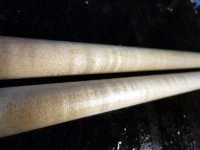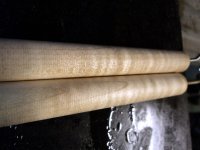Western big leaf maple is the softest maple I know of that is commonly used in cues, and it is not used as shafts. Red maple gets used a lot because it's often very curly, but still softer than the hard maples & not suitable for shafts. However, it is prone to hybridizing with black maple, which is a hard maple, & that wood is often sold as hard maple right along with black maple & sugar maple. Black maple is also prone to hybridizing with sugar maple, so in a mixed hardwood forest that has all three species of maple growing in close proximity, it's a crap shoot as to what is actually there. Evolution likely created a tiny subspecies unique to the specific environment & it's honestly almost impossible to tell what the tree is without DNA. And don't forget silver maple. It often gets milled & labelled as hard maple even though it's not as hard as sugar maple. There's even chalk maple, an almost unknown undergrowth tree that is hard & resiliant like sugar maple but very white & doesn't produce the sugar. Trees large enough for harvest are absolutely good for shafts. And all produce curly figure.
The biggest myth about maple is that only the best comes from northern MI or Canada. The MOST comes from there, but not the best. Certain shoreline areas of UPMI produce the most & best birdseye maple, while the Adirondacks & Alleghenies in NY across to Maine produce the straightest grain and curliest maple. The mountain areas have a much more mixed hardwood selection & maples are not the "big" trees like they are in more northern areas, so they are undergrowth trees that grow very straight, slow, and don't branch out. They're not as abundant, either. You don't find a forest full of sugar maples like I have seen in UPMI. But the area is much larger, covering a range from SE PA, across to NC & all the way up through ME, and everything between. Sugar maple actually grows all the way down to Florida & as far west as TX & OK. Even out here in NM we have a variation of sugar maple that grows high in the mountains, and it's VERY hard, but tough to find straight enough for shafts. Point being, shaft quality maple grows pretty much all over, just more abundant in some areas than others.
IMO, I prefer to use undergrowth wood from any of the mountain forests of the Appalachians, whether it be rolling hills of PA, OH, WV, KY, or the larger ranges of the Alleghenies & Adirondacks. Having studied maple extensively & continually doing so, I consistently find the straightest, heaviest, strongest wood comes from these mountain areas. They may not commercially produce as much as Canada & MI, but the wood is better suited for shafts, IMO. I'm actually pursuing a degree in forest ecology & plant biology, specifically for the purpose of studying trees & the way environmental characteristics affect lumber qualities.
And to get back on topic, I personally think curly shafts tend to be harder with better flex memory. However, one must be selective & careful which curly wood to use as shafts. There are various reasons the figure is formed and as such various qualities. I prefer the "fiddleback" curl that comes from heavy, dense trees that are buckling under their own weight. This wood is sought after by violin & fiddle makers for a reason. But the stringed instrument luthiers won't touch other forms of curl that result from odd growth pattern or damage or stump wood. They want the fine, tight curl that comes from a straight, healthy, strong tree. Unfortunately, so do veneer mills. So it's not easy to acquire. But it makes fore awesome shafts....and forearms.....and handles.....


